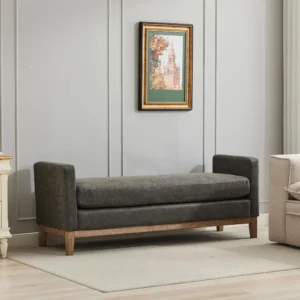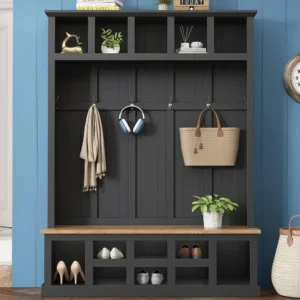The Function and Style of Entryway Benches and Trees: A Perfect Pairing
Walk into any well-designed home, and you’ll notice how the entryway sets the tone for the entire living space. At the heart of these welcoming entryways are two essential furniture pieces that work in harmony: the entry tree and the entryway bench.
Entry trees (often called hall trees) are those versatile pieces that combine hooks for coats and bags, shelves for small items, and sometimes mirrors for last-minute appearance checks. When paired with a complementary bench, they create the perfect entryway solution – combining organization with comfortable seating. This powerful duo not only helps tame the chaos of shoes, bags, and outerwear but also makes a strong style statement.
The relationship between these two pieces goes beyond mere function. The visual harmony between your bench and entry tree creates a cohesive look that elevates your entire entryway. Historically, entryway furniture has evolved from simple coat stands and separate seating to these integrated solutions that maximize both style and function.
Finding the right bench to complement your entry tree requires understanding various space-saving entryway benches and styles. From classic wooden designs to modern minimalist options, the perfect bench should reflect your personal style while working in concert with your hall tree or coat rack bench.
Key Design Principles for Matching Benches with Entry Trees
Creating a cohesive entryway means understanding how benches and entry trees should relate to each other. These key design principles will help you create harmonious pairings:
Material Compatibility
For a unified look, coordinate materials between your bench and entry tree. Wood tones should complement each other – either match exactly or intentionally contrast. Metal finishes should maintain consistency – brushed nickel hardware looks disjointed with brass accents. Fabric elements should speak the same design language, with textures and patterns that enhance rather than compete.
Scale and Proportion
Size relationships matter tremendously in entryway design. Your bench should never overpower your entry tree or vice versa. Generally, benches should be slightly shorter in length than the width of the hall tree or approximately two-thirds the width for balanced proportions. The perfect entryway bench height typically ranges between 17-20 inches for comfortable seating.
Visual Weight Balance
Even when materials differ, the “heaviness” of both pieces should feel balanced. A substantial wooden hall tree pairs well with a bench that has similar visual weight, while a delicate metal entry tree might need a lighter-looking bench to maintain harmony.
Color Coordination
Colors don’t need to match exactly, but they should exist in the same family or complement each other purposefully. Consider using the color wheel for guidance – complementary colors (opposite on the wheel) create dynamic looks, while analogous colors (adjacent) create harmonic palettes.
Design Language Consistency
The architectural elements of both pieces should speak the same design language. Curved elements should appear in both pieces if present, and likewise with angular features. When a hall tree features elaborate scrollwork, the bench should echo similar detailing rather than displaying stark minimalism.
Classic Wood Bench Styles for Traditional Entry Trees
Traditional wooden benches provide timeless appeal and durability for classic entryways. These styles particularly complement traditional entry trees:
Mission/Craftsman Style Benches
- Characterized by straight lines and exposed joinery
- Emphasis on highlighting wood grain patterns
- Often features vertical slats in the backrest
- Quarter-sawn oak is the traditional wood choice
- Pairs beautifully with mission-style hall trees with similar straight lines
Colonial/Shaker Style Benches
- Clean, simple designs with tapered legs
- Minimal ornamentation with focus on proportions
- Often includes practical storage drawers
- Common woods include cherry, maple and pine
- Matches wonderfully with straightforward entry organization systems
Queen Anne and Victorian Ornate Benches
- Distinguished by cabriole legs and curved lines
- Often features decorative carvings or inlay work
- May include tufted upholstery elements
- Mahogany and cherry woods predominate
- Storage typically includes hinged seat tops for blankets or seasonal items
When selecting a classic wooden bench, look for turned legs, carved details, and wood tones that match or intentionally contrast with your entry tree. The beauty of wood entryway benches lies in their ability to age gracefully while providing decades of functional seating and storage.
Modern and Contemporary Bench Options for Sleek Entry Trees
For those who prefer clean lines and forward-thinking design, modern and contemporary benches offer the perfect complement to sleek entry trees:
Minimalist Bench Designs
- Characterized by simple, geometric forms
- Emphasis on clean lines without unnecessary ornamentation
- Often features floating or cantilevered appearances
- Material honesty – letting wood, metal or concrete express natural beauty
- Pairs perfectly with streamlined, hardware-minimal entry trees
Mixed Material Modern Benches
- Combines contrasting materials for visual interest
- Popular combinations include wood seats with metal frames
- Glass elements may be incorporated for lightness
- Material transitions are highlighted rather than hidden
- Creates dynamic tension when paired with single-material entry trees
Geometric Contemporary Designs
- Features intentional asymmetry or unexpected angles
- May incorporate geometric cutouts or patterns
- Often utilizes unique joinery as design features
- Storage solutions integrated seamlessly into the design
- Complements entry trees with similar geometric sensibilities
Modern storage solutions typically feature hidden compartments, push-open mechanisms, or clever multi-functional elements. These modern entryway benches showcase how functionality doesn’t require sacrificing clean aesthetics.
The beauty of contemporary design lies in its adaptability – these sleek benches for modern entryways can work in various settings from industrial lofts to minimalist apartments, providing the perfect foundation for your entryway organization.
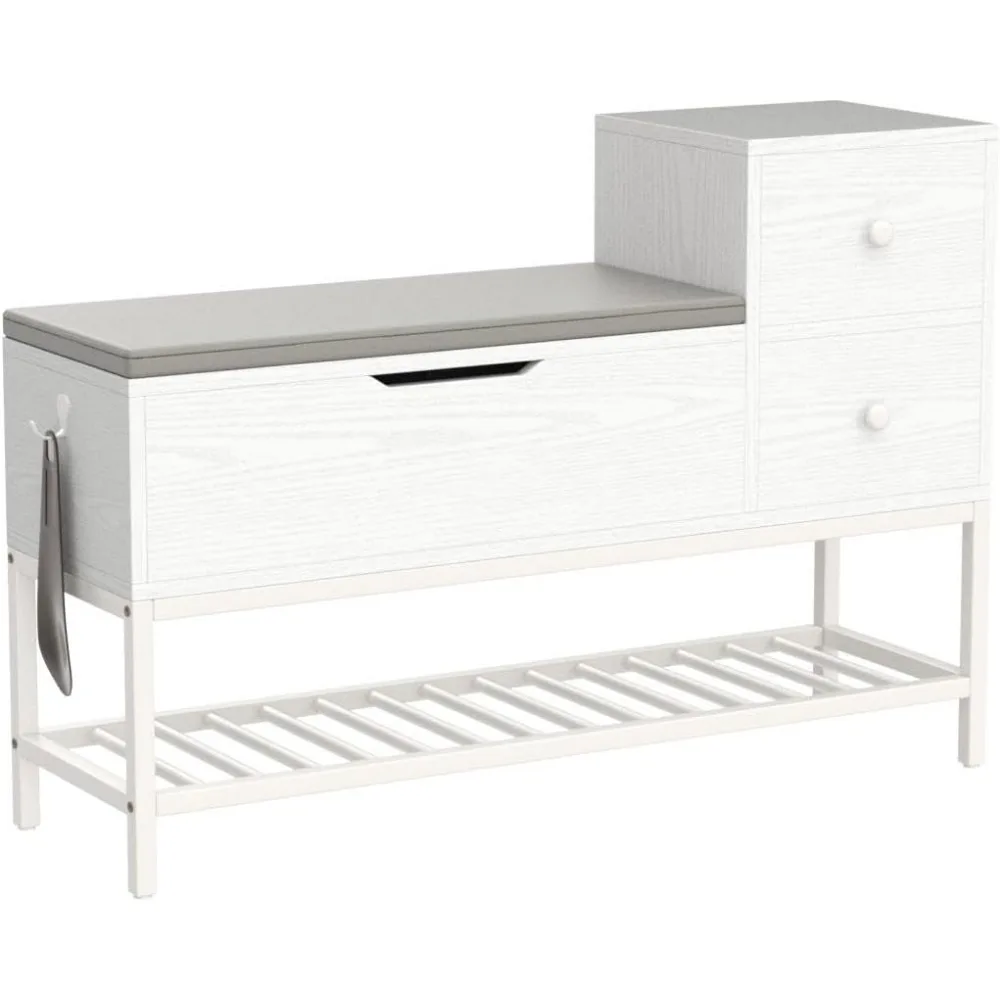
Rustic and Farmhouse Bench Styles for Cottage-Inspired Entry Trees
For homes that embrace cozy, lived-in charm, rustic and farmhouse bench styles create welcoming entryways with character and warmth:
Reclaimed Wood Benches
Reclaimed wood benches tell a story through their weathered surfaces and distinctive markings. These pieces feature natural knots, nail holes, and color variations that showcase their previous lives. When paired with entry trees using similar reclaimed materials, they create an authentic, environmentally-conscious entryway with unmistakable character.
Barn Door Inspired Designs
Taking cues from traditional agricultural architecture, these benches incorporate X-bracing, plank construction, and hardware that mimics barn door tracks. The substantial construction and straightforward joinery create sturdy seating that complements entry trees with similar rustic elements like hook boards and wooden pegs.
Weathered and Whitewashed Finishes
Benches with intentionally aged finishes—from gentle distressing to heavily weathered appearances—create that perfect “been there forever” feel. Whitewashed and milk paint finishes offer a softer alternative that brightens spaces while maintaining rustic appeal. These finishes work beautifully alongside similarly treated entry trees.
Metalwork Accents
Blacksmith-style hardware, decorative hinges, and industrial metal accents add authentic charm to rustic benches. These details should coordinate with the hardware on your entry tree, creating visual connections between the pieces through repeated elements like hand-forged hooks or strapping.
The magic of farmhouse entryway benches lies in their ability to feel both timeless and current. The best rustic combinations embrace texture contrasts—rough against smooth, aged against new—creating visual interest while maintaining a cohesive country-inspired aesthetic.
Industrial Style Benches for Urban Entry Tree Systems
Industrial design celebrates functional elements and raw materials, perfect for contemporary urban spaces and loft-inspired interiors:
Metal and Wood Combination Benches
- Contrasts warm wood tones with cool metal finishes
- Often features exposed fasteners as design elements
- Wood typically shows natural character with minimal finishing
- Metal frameworks provide substantial support with visual lightness
- Complements industrial entry trees with similar material combinations
Pipe Fitting and Raw Steel Elements
- Utilizes plumbing pipes and fittings as structural components
- Embraces the unfinished look of raw or lightly sealed steel
- May incorporate expanded metal mesh or perforated steel elements
- Often features exposed welds and connections
- Pairs beautifully with entry systems using similar industrial components
Factory-Inspired Design Elements
- Incorporates wheel casters for mobility and industrial flair
- May include adjustable height mechanisms
- Sometimes features numbered lockers or factory bin storage
- Often utilizes stamped metal details or industrial labeling
- Creates cohesion with factory-inspired hall tree designs
Leather and Canvas Seating Options
- Utilizes saddle leather or canvas for durable seating surfaces
- Typically attached with visible rivets or heavy-duty stitching
- Ages beautifully, developing patina with use
- Provides warmth and tactile contrast to metal elements
- Complements industrial entry trees with similar upholstery details
For narrow spaces, space-saving benches for narrow entryways in industrial styles offer practical solutions without sacrificing the authentic workshop aesthetic. The beauty of industrial design lies in its honest approach to materials and function, celebrating rather than concealing structural elements.
Upholstered Bench Options for Softer Entry Tree Aesthetics
When your entryway needs a touch of comfort and softness, upholstered benches provide the perfect welcoming element:
Fabric-Covered Options
Fabric-upholstered benches add texture, color, and comfort to entryways. Options range from crisp linens and cotton blends to plush velvets and textured weaves. When pairing with wooden entry trees, fabric benches soften the overall look and provide an opportunity to introduce pattern and color that complements your home’s interior design scheme.
Leather and Faux-Leather Choices
Leather benches offer unmatched durability for high-traffic entryways while adding sophisticated texture. Available in everything from distressed vintage finishes to sleek contemporary treatments, leather complements both wooden and metal entry trees. For budget-conscious or vegan-friendly options, today’s high-quality faux leathers provide similar aesthetics with impressive durability.
Pattern and Texture Considerations
When selecting upholstered benches to pair with entry trees, consider how patterns interact with the visual elements of your tree. Subtle textures often work best with ornate hall trees, while bolder patterns can enhance simpler designs. The key is finding balance—letting either the bench or the tree be the statement piece while the other plays a supporting role.
Performance Fabrics for High-Traffic Areas
Modern performance fabrics offer stain resistance, water repellency, and fade protection without sacrificing style. These practical options come in numerous textures and colors, making them ideal for entryway benches that face daily use. Look for options with 30,000+ double rubs for maximum durability.
For the ultimate in comfort and style, consider entryway bench cushions that can be changed seasonally or whenever you’re ready for a fresh look. Many upholstered benches also include hidden storage under hinged seats, combining comfort with functionality.
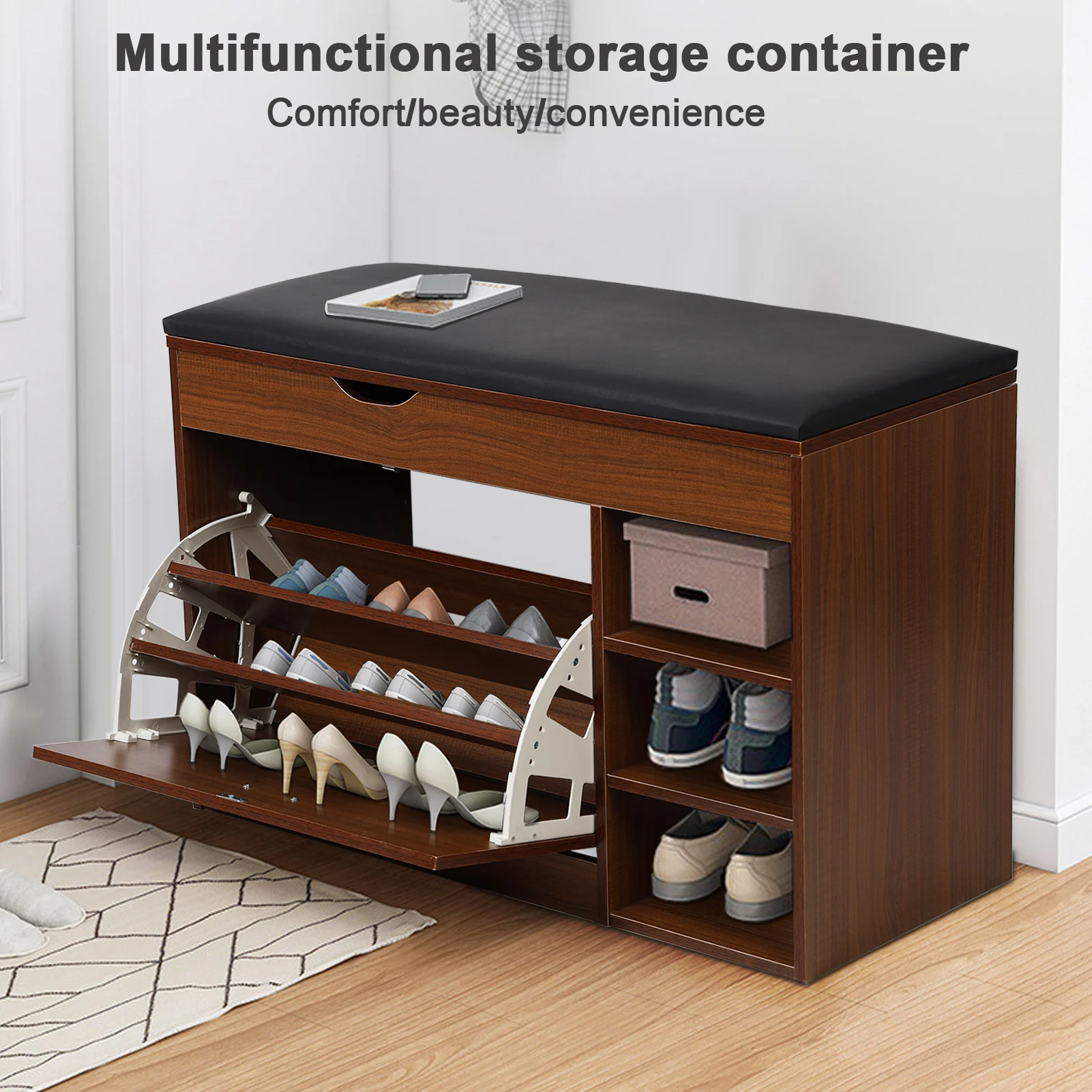
Size and Scale: Choosing the Perfect Bench Dimensions
Finding the right-sized bench for your entryway involves careful consideration of your space and needs:
Standard Bench Dimensions
Most entryway benches fall within these general dimensions:
* Width: 36-60 inches (varies based on available space)
* Depth: 14-18 inches (allows for comfortable seating without protruding too far)
* Height: 17-20 inches (standard seating height)
For optimal proportion, your bench should typically be 60-80% of your entry tree’s width for visual balance.
Measuring Your Space
Before purchasing, measure your entryway carefully, accounting for:
* Door swing clearance (minimum 30 inches)
* Walking path width (minimum 36 inches)
* Wall space available for the bench-tree combination
* Ceiling height (for tall hall tree units)
Mark the footprint with painter’s tape on your floor to visualize how the pieces will fit.
Small-Space Solutions
For compact entryways, small benches for entryways provide seating without overwhelming limited space. Look for:
* Corner bench designs that maximize awkward spaces
* Narrow profile benches (12-14 inches deep)
* Wall-mounted options that free up floor space
* Nesting designs that can be partially tucked away when not in use
The perfect bench should provide comfortable seating while maintaining proper traffic flow in your entryway, creating a welcoming but functional space.
Storage Features: Maximizing Functionality in Entryway Benches
The right storage features transform a simple bench into an organizational powerhouse for your entryway:
Flip-Top Storage Designs
- Hidden storage compartment beneath hinged seat
- Perfect for seasonal items like gloves, scarves, and hats
- Some feature divided compartments for better organization
- Hydraulic hinges prevent slamming and pinched fingers
- Complements entry trees by handling overflow storage needs
Cubbies and Shelf Systems
- Open storage for frequently used items
- Ideal for shoe storage with 4-8 pairs capacity
- Can be combined with baskets for containing smaller items
- Creates visual continuity with shelf systems on entry trees
- Allows for decorative and functional elements to coexist
Drawer Configurations
- Concealed storage for items best kept out of sight
- Protects valuables like keys, mail, and small electronics
- Some feature divided interiors for better organization
- Full-extension glides allow complete access to contents
- Complements entry trees by handling smaller item storage
Basket Integration Options
- Removable baskets allow flexible organization
- Perfect for separating items by family member
- Enables quick cleanup by gathering scattered items
- Natural materials add warmth and texture
- Coordinates with entry tree aesthetics while adding function
Entryway benches with storage are particularly valuable in homes without dedicated mudrooms or closets near the entrance. When selecting storage features, consider your family’s specific habits and needs – from sports equipment to pet supplies – to create a truly functional entryway system.
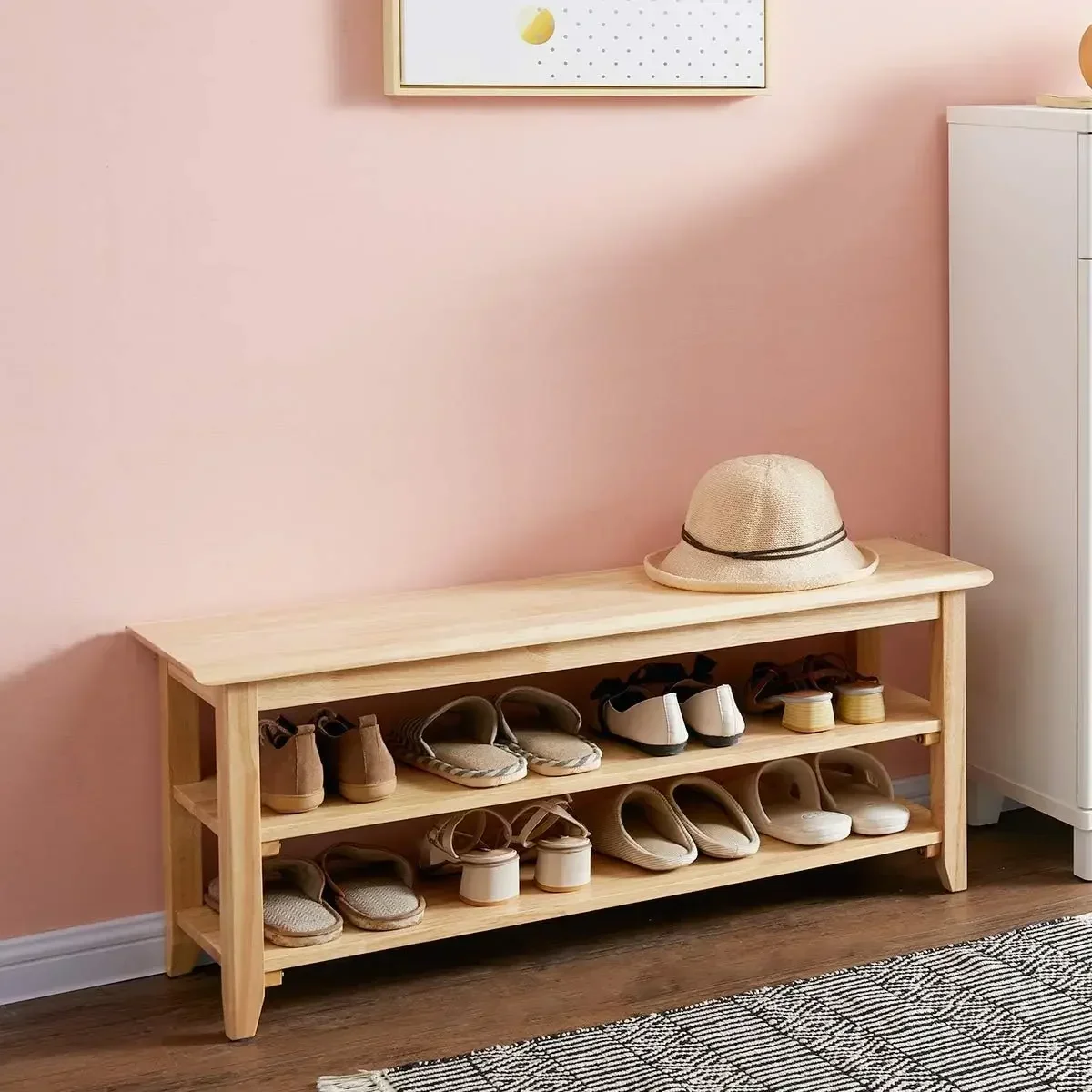
How to Create a Perfect Bench and Entry Tree Combination (Buying Guide)
Follow these steps to create an entryway combination that’s both beautiful and functional:
Step 1: Assess Your Entryway’s Specific Needs
Consider who uses your entryway and how. Do you need storage for a family of five with sports equipment, or is it just for occasional guests? Track your entryway traffic patterns for a week, noting what items accumulate and what storage would help. This foundational understanding will guide all subsequent decisions.
Step 2: Measure Your Space and Determine Size Constraints
Accurate measurements prevent costly mistakes. Measure wall length, ceiling height, and available floor space. Allow at least 36 inches for walking paths and consider door clearance. These measurements will determine the maximum dimensions for your bench and entry tree combination.
Step 3: Consider Your Home’s Overall Design Aesthetic
Your entryway should complement your home’s existing style. Take photos of adjacent rooms and note architectural details, color schemes, and dominant materials. Your bench and entry tree should either match this aesthetic or intentionally contrast in a pleasing way.
Step 4: Determine Essential Storage Features Required
Based on your needs assessment, list must-have storage features. Do you need shoe storage for multiple pairs? Hidden storage for valuables? Hook capacity for a certain number of coats? Prioritize these features to guide your selection process.
Step 5: Evaluate Material Durability Based on Usage
High-traffic entryways require durable materials that withstand daily abuse. Consider how materials perform under your specific conditions: Will they face wet boots? Scratchy pet claws? Sunlight exposure? Choose materials and finishes that will maintain their appearance despite these challenges.
Step 6: Select Complementary Finishes Between Bench and Entry Tree
Finally, ensure visual harmony between your bench and entry tree through complementary finishes. This doesn’t mean identical matches—contrast can be beautiful when intentional. Look for connecting elements like similar wood tones, coordinating metal finishes, or complementary design motifs.
For complete solutions, consider entryway coat rack bench combinations that are designed to work together. These matched sets eliminate guesswork while providing comprehensive organizing tips for entryway bench setups.
Entryway Bench with Cushion, Mudroom Bench with Cushion, Shoe Bench for Entryway
$1,186.63 Select options This product has multiple variants. The options may be chosen on the product pageCoat Rack Shoe Bench, Corner Entryway Bench, Corner Hall Tree, Shoe Bench for Entryway
$313.58 Select options This product has multiple variants. The options may be chosen on the product pageEntryway Bench with Back, Modern Entryway Bench, Shoe Bench for Entryway
Price range: $463.13 through $474.44 Select options This product has multiple variants. The options may be chosen on the product pageCorner Entryway Bench, Entryway Bench with Cushion, Modern Entryway Bench, Shoe Bench for Entryway
$476.34 Select options This product has multiple variants. The options may be chosen on the product pageBench with Hooks and Storage, Entryway Hall Tree, Mudroom Bench with Cubbies, Mudroom Bench with Shoe Storage
$818.38 Select options This product has multiple variants. The options may be chosen on the product pageModern Entryway Bench, Wood Entryway Bench, Wood Mudroom Bench
$497.69 Select options This product has multiple variants. The options may be chosen on the product page
Is a Built-In Bench Right for Your Entry Tree Setup?
Custom built-in benches offer unique advantages when paired with entry trees, but they aren’t right for every home. Consider these factors:
Built-in benches create seamless integration with your architecture, making the entryway feel intentionally designed rather than furnished. They can be precisely sized to your specific space, maximizing every inch while accommodating architectural quirks like uneven walls or awkward corners.
However, built-ins represent a significant commitment both financially and physically. While freestanding benches typically cost $100-600, built-ins generally start at $500 and can exceed $2,000 depending on materials and complexity. They also become part of your home, potentially impacting resale value if the design is too personalized.
Built-ins make the most sense when:
* Your entryway has unusual dimensions that standard furniture can’t accommodate
* You plan to remain in your home long-term
* You want to maximize storage in a challenging space
* Your home’s architectural style would benefit from custom carpentry
Freestanding options are better when:
* You prefer flexibility to rearrange your entryway
* You’re renting or planning to move
* You want to test a layout before committing
* Budget constraints make custom work prohibitive
Many homeowners find that various hall tree bench styles can provide the built-in look without the permanence, offering an attractive middle ground.
Can You Mix Wood Tones Between Entry Benches and Trees?
Mixing wood tones can create rich, layered entryways when done thoughtfully. Unlike the perfect matching sets of past decades, today’s design embraces intentional mixing for character and depth.
The key to successful wood tone mixing lies in understanding undertones. Woods with warm undertones (cherry, mahogany, walnut) generally work well together, as do those with cool undertones (ash, maple with gray finishes). The contrast should feel purposeful rather than accidental.
For successful mixing:
* Keep one wood as the dominant tone (typically the larger piece)
* Look for woods with similar grain patterns or complementary characteristics
* Use connecting elements like hardware or accessories in finishes that bridge both woods
* Consider pieces from the same design style even if woods differ
* Maintain consistent sheen levels across different wood pieces
When mixing feels too challenging, hardware provides an excellent unifier. Black iron hardware can tie together different wood tones while adding character to your space-saving entryway ideas.
In smaller entryways, limiting variation helps prevent visual chaos. Consider matching woods more closely in compact spaces while embracing more contrast in larger entryways.
How to Accessorize Your Entry Bench to Complement Your Tree
The finishing touches on your entryway bench can tie your entire entry together while adding personality and function:
Cushions and Pillows
Add comfort and color with bench cushions that complement your overall design. For traditional spaces, look for piped edges and classic patterns. Modern spaces benefit from clean-lined cushions in solid colors or geometric patterns. Consider washable covers for high-traffic areas and seasonal options to refresh your space throughout the year.
Seasonal Transitions
Your entryway can reflect the changing seasons with thoughtful accessories. In winter, add warm throws and plush cushions alongside boot trays for practicality. Summer calls for lighter fabrics, perhaps woven baskets for outdoor essentials, and fresh floral arrangements. These seasonal adjustments keep your entryway feeling current and welcoming.
Functional Accessories
Practical elements can be both beautiful and useful. Consider:
* Decorative boot trays that protect floors while adding style
* Stylish baskets that contain small items while adding texture
* Small bowls or dishes for keys and pocket items
* Umbrella stands that complement your bench and tree materials
Lighting Elements
Thoughtful lighting transforms your entryway combination. A table lamp on one end of the bench creates ambiance, while picture lights can highlight artwork above your bench. Consider sconces that frame your entryway hall tree for a designer-worthy entrance that welcomes guests with proper illumination.
The most successful entryway accessories maintain visual balance while enhancing functionality. Avoid overcrowding your bench with decorative items that impede its primary purpose as seating. Instead, select fewer, more impactful pieces that complement both the bench and entry tree while making your entryway more inviting and functional.


